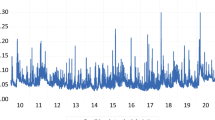Abstract
Charles Schwab Inc. appears to expend a great deal of effort analyzing stocks from many perspectives and rating their potential for future returns over a 12-month investment horizon. This study examines whether their analysis explains returns beyond known variables. Schwab’s equity ratings are an interesting dataset to study because their ranking methodology appears to highly correlate with known academic research. Examining an original sample size of 3074 stocks and using the Year 2014 as a test sample, evidence is presented that Schwab’s ex-ante analysis does add explanatory value to ex-post returns, especially in the presence of firm Beta, firm size and a stock’s nearness to its 52-week high.


Similar content being viewed by others
Notes
In 2002, the Securities and Exchange Commission indirectly addressed the historical imbalance in “buy” versus “sell” recommendations by strengthening the disclosure of potential conflicts of interest between corporations and their investment banker.
See Malmendier and Shanthikumar (2014) and others for literature reviews.
The largest and smallest firms in the sample of 3074 firms are $494 and $0.075 billion respectively. Approximately 54 % of the sample firms have a market cap of $2 billion or larger.
See Sturm (2013) for a discussion.
See Ball and Brown’s (1968) seminal paper and many others who followed.
Such academic studies date back to at least the early 1900’s (see Cootner 1964 and others).
There is an overlap of about 4 trading days over the holiday period between SERP and the HPR. For purposes of this study and because it applies to the entire sample, the overlap is inconsequential.
None of the stocks were from the same SERP, so the excluded stocks should have no significant impact on the results.
See Sturm (2013) for a discussion of the overlap between technical analysis and market efficiency.
Of course, this relation has been shown to not always hold. See Fama and French (1992) and many other studies that followed.
Beta exhibits the highest and most statistically significant correlation with returns, results not reported. Orthogonal values are used for all multi-variate regressions while the unorthogonalized variables are used for all univariate regressions.
For Beta, numerically higher ratings are assigned to lower Beta stocks and for size, numerically higher ratings are assigned to larger firms.
Stocks further away from their 52-week high were assigned numerically higher ratings and vice versa.
References
Atkinson S, Sturm RR (2003) Allstar mutual funds? J Invest 12(2):87–95
Ball R, Brown P (1968) An empirical evaluation of accounting income numbers. J Account Res 6:159–178
Barber B, Lehavy R, McNichols M, Trueman B (2001) Can investors profit from the prophets? Security analyst recommendations and stock returns. J Financ 56:531–563
Blake CR, Morey MR (2000) Morningstar Ratings and Mutual Fund Performance. J Financ Quant Anal 35(3):451–483
Cootner PH (1964) The random character of stock market prices. The Massachusetts Institute of Technology press, Cambridge
Fama EF, French KR (1992) The cross-section of expected stock returns. J Financ 47(2):427–465
George TJ, Hwang CY (2004) The 52-week high and momentum investing. J Financ 59(5):2145–2176
Giacomino DE, Akers MD (2011) Examining an online investment research service: the motley fool. J Bus Econ Res 9(1):37–48
Hong H, Stein JC (1999) A unified theory of underreaction, momentum trading, and overreaction in asset markets. J Financ 54(6):2143–2184
Holloway , Clark, A (1981). Note on Testing an Aggressive Investment Strategy Using Value Line Ranks. J Financ, 36,3, pp. 711–719.
Jegadeesh N, Kim J, Krische SD, Lee C (2004) Analyzing the analysts: when do recommendations add value? J Financ 59(3):1083–1124
Jegadeesh N, Titman S (1993) Returns to buying winners and selling losers: implications for stock market efficiency. J Financ 48(1):65–91
Lim B, Rosario J (2010) The Performance and Impact of stock picks mentioned on ‘Mad Money. Appl Financ Econ 20(14):1113
Malmendier, U., & Shanthikumar, D. (2014). Do security analysts speak in two tongues? Review of financial studies, hhu009.
Olson DO, Nelson J, Witt C, Mossman C (1998) A test of the investor’s daily stock ranking system. Financ Rev 33(2):161–176
Schadler FP, Eakins SG (2001) Merrill Lynch’s focus stock picks: a test of analysts' stock picking ability. Q J Bus Econ 40(2):17–30
Sharpe WF (1966) Mutual fund performance. J Bus 1966(39):119–138
Sturm RR (2013) Market Efficiency and Technical Analysis: Can they Coexist? Res Appl Econ 5(3):1–16
Szakmary AC, Mitchell Conover C, Lancaster C (2008) An examination of Value Line’s long-term projections. J Bank Financ 32(5):820–833
Womack KL (1996) Do brokerage analysts' recommendations have investment value? J Financ 51(1):137–167
Author information
Authors and Affiliations
Corresponding author
Rights and permissions
About this article
Cite this article
Sturm, R.R. Schwab’s equity ratings: value added or old news?. J Econ Finan 41, 257–275 (2017). https://doi.org/10.1007/s12197-015-9347-1
Published:
Issue Date:
DOI: https://doi.org/10.1007/s12197-015-9347-1




